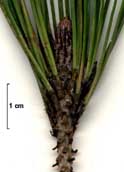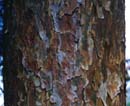
Shoot of an ornamental specimen (Seattle, WA) showing foliage and twig [C.J. Earle, 28-Feb-1999].

Bark of an ornamental specimen in Seattle (USA) [C.J. Earle, 28-Feb-1999]. |
Pinus densiflora
Siebold & Zuccarini 1842
Common NamesJapanese red pine, AKA-MATSU, ME-MATSU (Japanese) (6).Taxonomic notesTwo varieties, funebris (syn: P. funebris), often considered to be the hybrid of P. densiflora and P. sylvestris (2); and sylvestriformis (Taken.) Wang (syn: P. sylvestris var. sylvestriformis (Taken.) Cheng & Chu.) (5).DescriptionTree: Straight to contorted (particularly in coastal settings), to 36m tall, with an open, irregular or umbrella-shaped crown. Lower branches shed early even in open settings (6, 7).Bark: Red-brown, in large plates (on old trees) or flaky and papery (6, 7). Branches: Rapidly becoming smooth with age, grey-green, developing papery reddish bark (7). Leaves: Green, pliable, 2 per fascicle, sheaths retained, 8-12 cm long, 0.7-1.2 mm wide, acute, with minute marginal teeth, stomata in lines on all surfaces; retained in bunches at ends of twigs (6, 7). Cones: Conic-ovoid, tan to golden brown, 4-7 cm long, in whorls of 2-5 at branch nodes, remaining closed and attached for several years, on a 1-3 mm long somewhat flexible peduncle (6). Cone scales: About 50 scales may contain fertile seed; cuneate, the exposed part flattened, rhomboidal with a central, short-mucronate umbo; the concealed part a dark red-brown (6). Pollen cones: Small, ellipsoidal, pale yellow or yellow-brown, at end of shoots (6, 7). Pollination in May; seeds mature in October (8). Seeds: Seeds with attached wing 10-17 mm long. Wood: Similar species: RangeChina (Shandong, Jiangsu), Korea, Japan (S Hokkaido, Honshu, Shikoko, Kyushu), and Russia: rare in southern Ussuriland on rocky slopes at 0-500 m or sandy soils, seashores, Khanka Lake islands (1, 8). Var. funebris found in Korea; China & Russia: Manchuria, N Ussuriland and Amur Valley (1), where it grows from sea level to 600 m (7). It occurs from the coast into the lower mountains, sometimes reaching to 2300 m elevation (6, 7). This species has an invasive adaptation to fire; fires typically kill it, but it can quickly establish and attain dominance in the aftermath of a severe fire. This invasive potential also makes it a good example of a species that has been favored by human disturbance; in Japan, it was an uncommon species before about 2500 BP, when human disturbance was minimal and severe fires were infrequent. Red pine becomes prominent in the fossil pollen record at about the time that agriculture becomes widespread, and its spread in Japan is strongly correlated with the rise of agriculture (3, 4).Big TreeOldestDendrochronologyEthnobotanyBesides following agriculture as a 'weedy' species, it is also one of the more popular ornamental pines, used as such in Japan since ancient times and now widely planted in Europe and North America.ObservationsRemarksI have seen an ornamental cultivar, 'umbraculifera', that bears small (3-4 cm long) cones in whorled clusters of 20-30 cones.Citations(1) Vladimir Dinets, e-mail communication, 10-Jan-1998.(2) Silba 1986. (3) Kremenetsi et al. 1998. Late Quaternary dynamics of pines in northern Asia, pp. 95-106 in Richardson 1998. (4) Agee 1998. Fire and pine ecosystems, pp. 193-218 in Richardson 1998. (5) De-Zhu Li. 1997. A reassessment of Pinus subgen. Pinus in China. Edinb. J. Bot. 54(3): 337-349. (6) Ohwi 1965. (7) Farjon 1984. (8) S. Harkevich and N. Kachura. 1981. Rare Plant Species of The Soviet Far East and Their Conservation. Nauka, Moscow (in Russian). |
|
[ Pinus ] [ Pinaceae ] [ home ]
This page is from the Gymnosperm Database
|